Challah
This post may contain affiliate links. Read my full disclosure policy.
With its rich, slightly sweet flavor, shiny golden crust, and pillowy interior, challah isn’t just for the Jewish holidays — it appeals to everyone, any time!
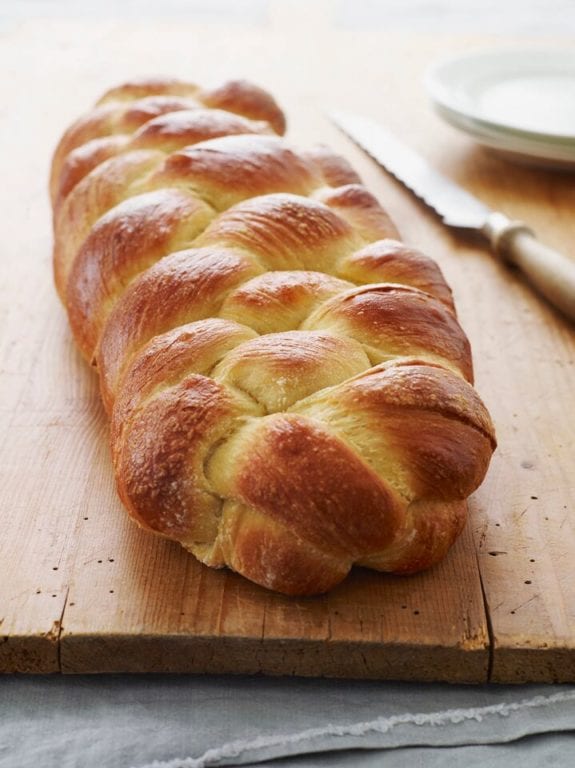
Photo by Alexandra Grablewski (Chronicle Books, 2018)
Challah is the bread of celebration in Jewish tradition, but I put it in the matzo ball soup and bagel category: it appeals to everyone. It’s a rich, slightly sweet loaf with a shiny, golden crust and pillowy-soft interior. But what makes it truly special is its distinctive braid, which symbolizes, among other things, the joining together of family and friends. Rest assured, challah looks like far more trouble than it actually is. Think of it as a once-in-a-while baking therapy project. Kneading and braiding the dough, smelling the challah baking in the oven—it really is satisfying. And when the long braided loaf is presented at the dinner table, it is a sight to behold!
I owe much of the credit for this recipe to Nanci Hirschorn, one of my lovely readers, who has been perfecting her challah recipe for over thirty-five years. Thank you, Nanci, for all the pointers! Heads up: this recipe makes one 16-in loaf. It’s huge! If you have leftovers, use it to make French toast.
Challah is part of my yeast bread collection, which includes other enriched bread recipes, like brioche and babka—rich-tasting breads with a higher proportion of eggs, sugar, butter, and milk—as well as classics like no-knead artisan bread, focaccia, dinner rolls, and naan.
Table of Contents
What You’ll Need To Make Challah
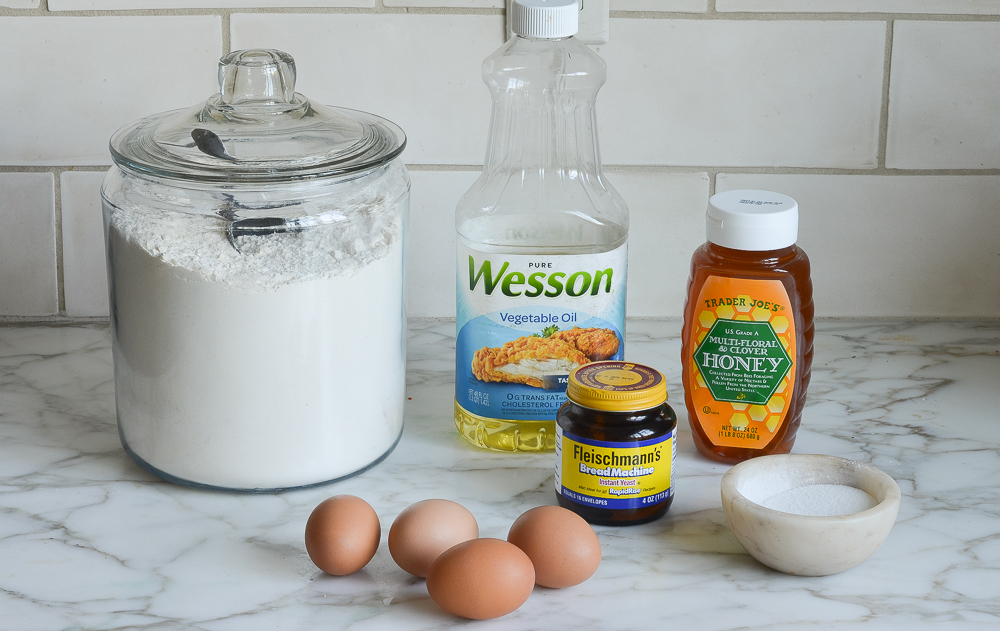
- All-purpose flour: Provides the structure and body of the challah, forming the base of the dough.
- Instant/rapid-rise yeast: Acts as the leavening agent, helping the dough to rise and giving the bread its light and airy texture. Note that this type of yeast rises faster than regular active dry yeast. Yeast is sold in jars (as pictured) or individual packets. If you don’t do a lot of bread baking, it’s best to buy the packets; just note that the quantity required for this recipe (1 tablespoon) is more than one packet.
- Salt: Enhances the flavor
- Lukewarm water: Hydrates the flour, activates the yeast, and helps bind the ingredients together to form the dough.
- Vegetable oil: Adds richness and moisture to the bread, contributing to its soft and tender crumb.
- Honey: Sweetens the dough and adds moisture, while also contributing to the flavor and helping with browning.
- Eggs: Provide richness, moisture, and structure to the dough, giving the challah its characteristic golden color and tender texture. Be sure your eggs are room temperature; this dough is slow to rise and cold eggs will slow it down even further.
- Jump to the printable recipe for precise measurements
How To Make Challah
Step 1: Make The Dough
Begin by combining the lukewarm water, oil, honey, 2 of the eggs, and the egg yolk; whisk well and set aside.
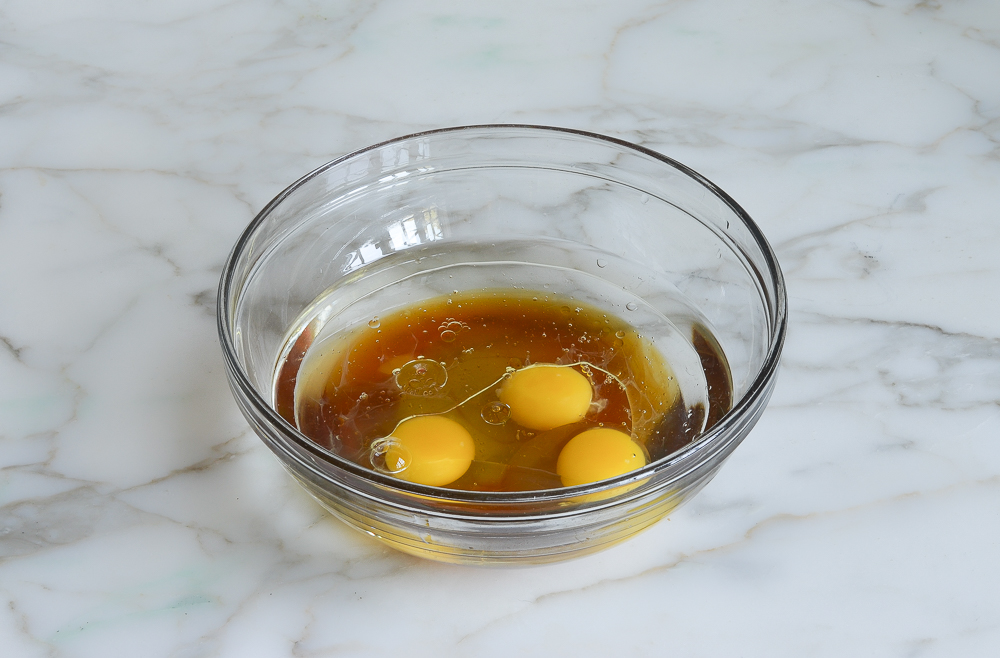
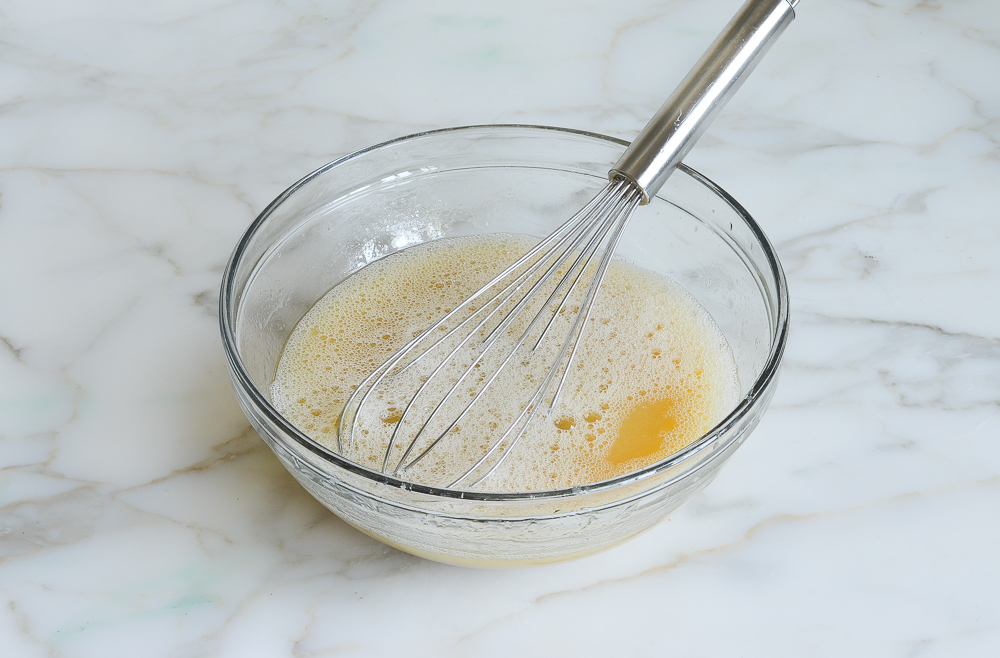
In a stand mixer fitted with the dough hook, combine the flour, yeast, and salt. Mix to combine.
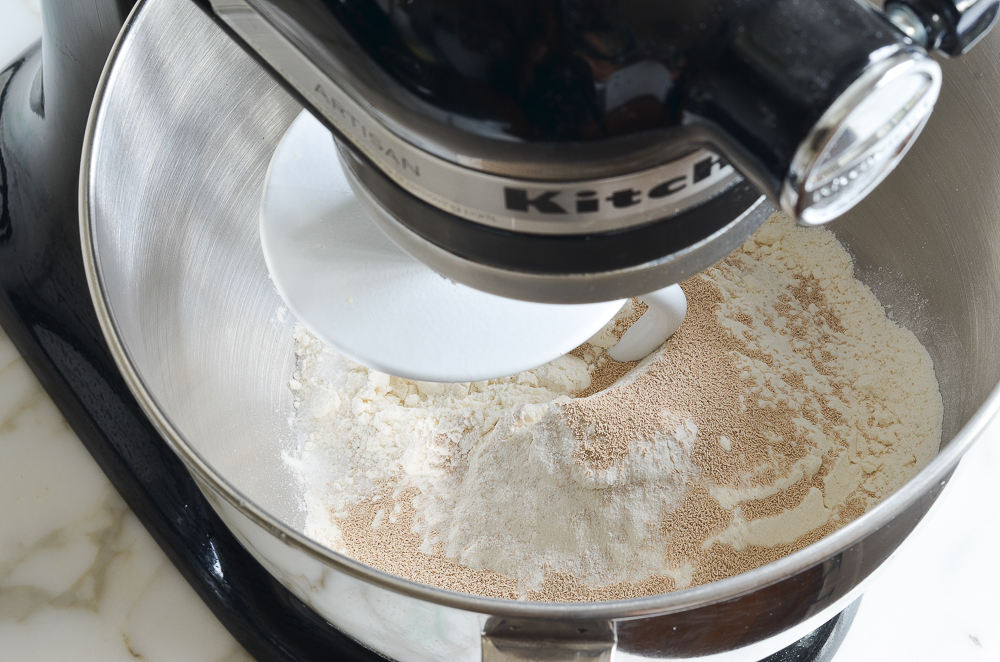
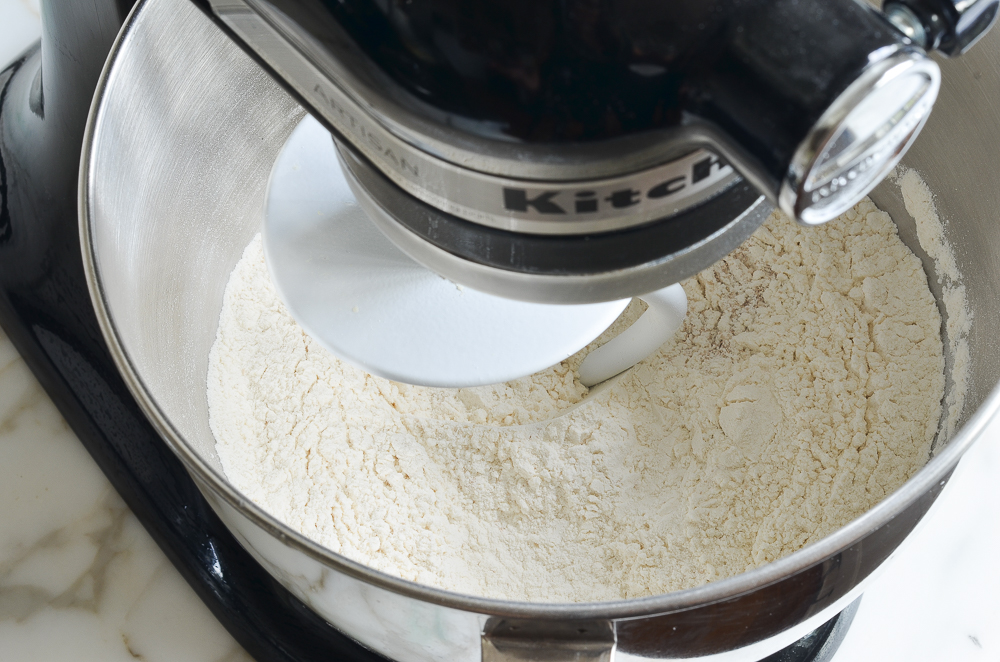
Add the liquid ingredients to the dry ingredients. Then knead on medium-low speed until you have a sticky dough that clings to the bottom of the bowl, 5 to 7 minutes. The dough may seem too wet but have faith—it’s supposed to be.
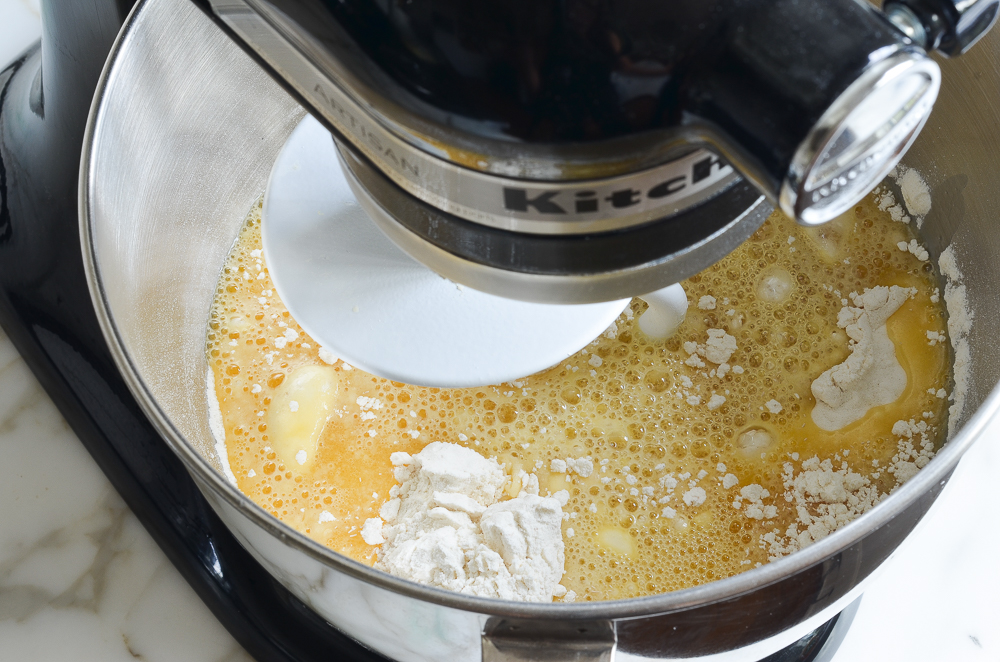
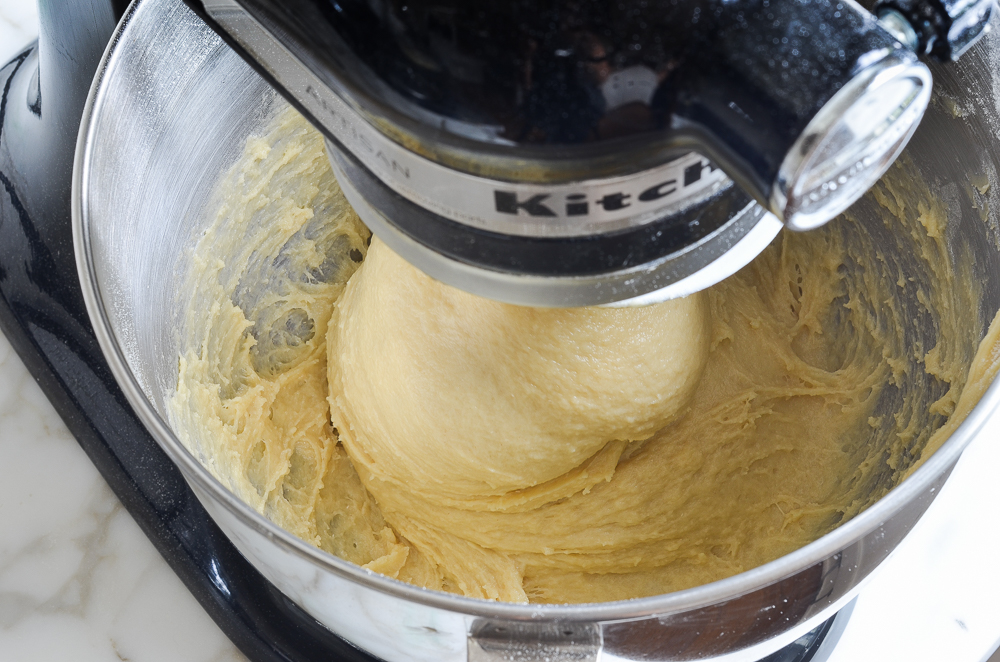
Dust your hands generously with flour, then scrape the sticky, elastic dough out onto a lightly floured work surface. Dust the top of the dough lightly with flour. Knead into a soft, smooth ball.
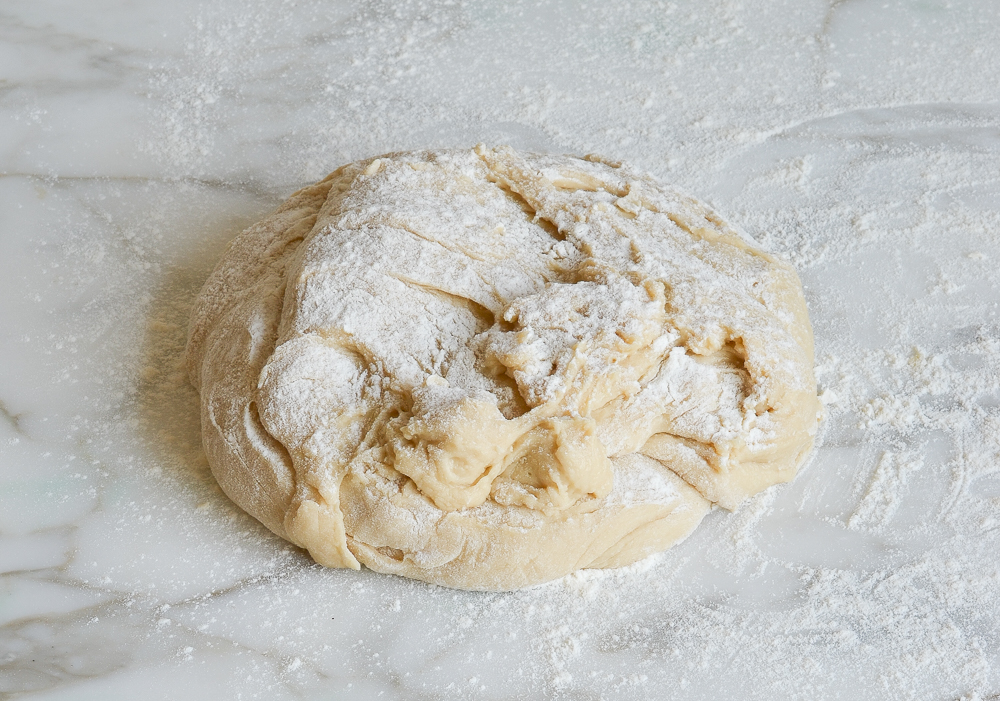
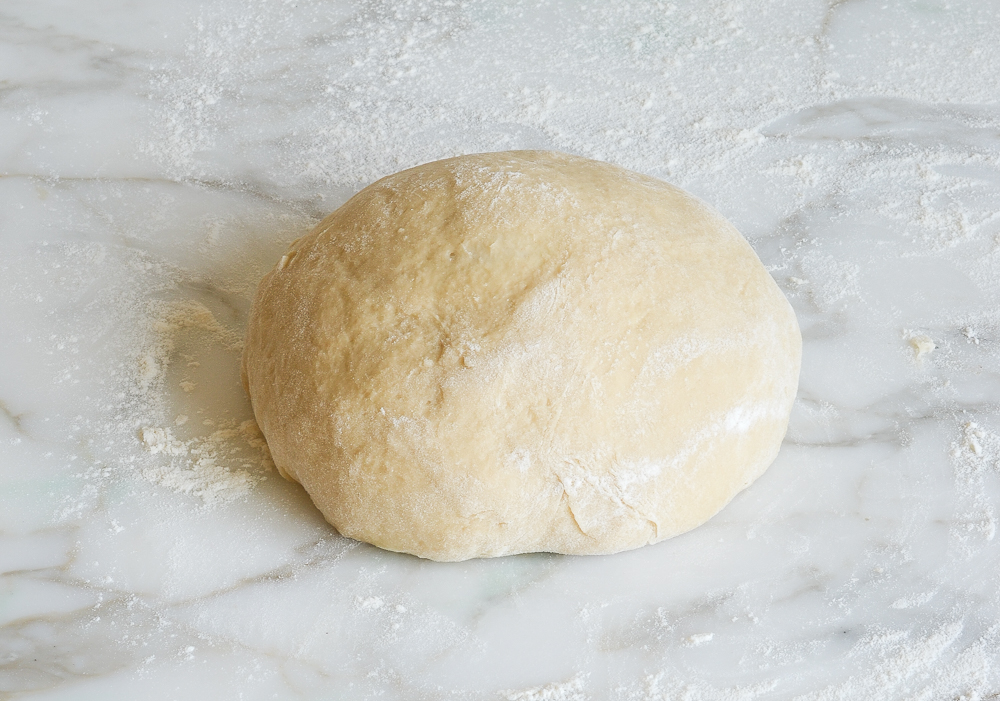
Step 2: Let it Rise
Lightly grease a large bowl with oil or nonstick cooking spray. Place the dough in the bowl, flip it over once so the top is lightly oiled, and then cover the bowl with plastic wrap. Allow the dough to rise in a warm, draft-free spot until it’s puffy and doubled in size, 2 to 3 hours. Keep in mind that when baking yeast breads, rising times are only a guide. The temperature in your kitchen, the humidity level outdoors, and how you knead the dough will all affect the rising time.
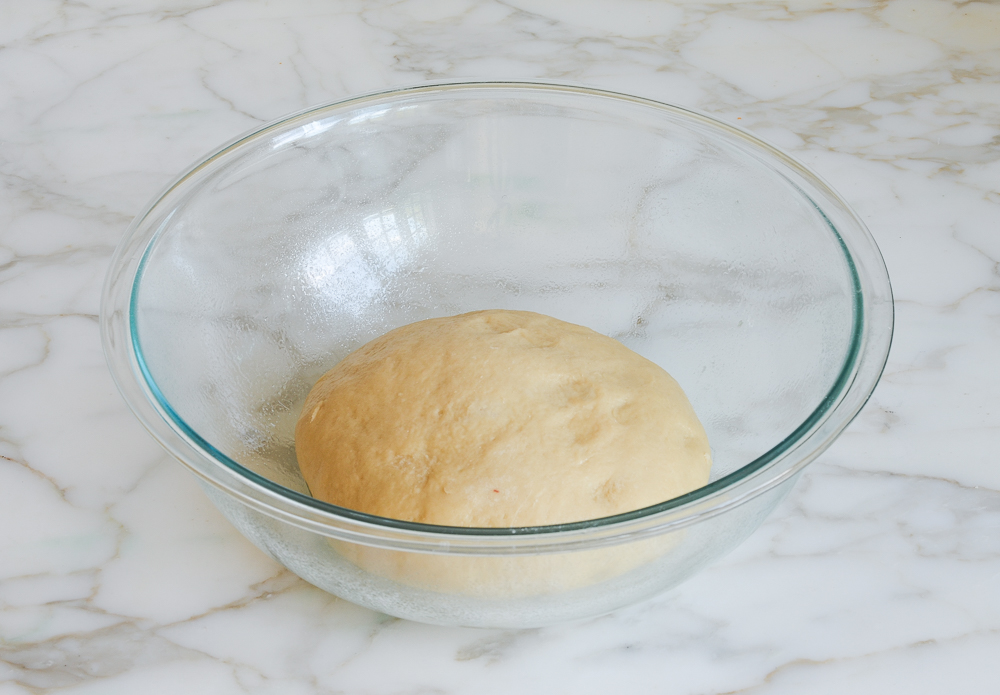

Step 3: Braid the Dough
If you have a little girl in your life, or were ever a summer camp counselor, you have an advantage with braiding challah. But even if not, I assure you it’s easy to do. There are dozens of methods, but I think this 4-strand braid is the easiest and the prettiest.
To begin, invert the risen dough onto a lightly floured work surface and dust with flour. It will deflate. Cut the dough into four even pieces. (If you want to be exact, each piece should weigh approximately 9 oz or 260 g.)
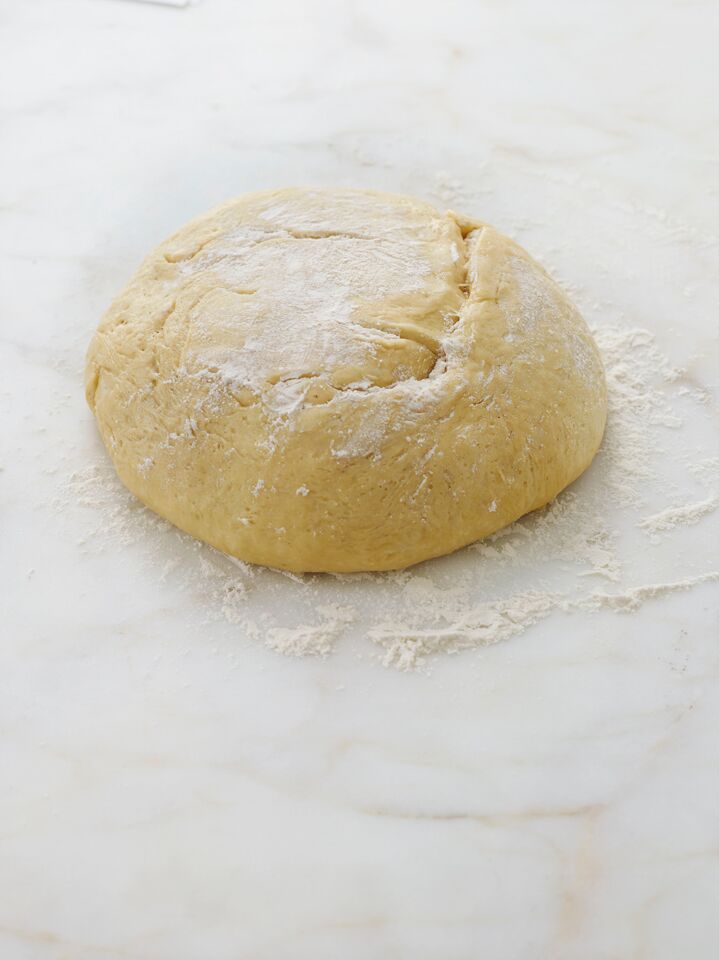
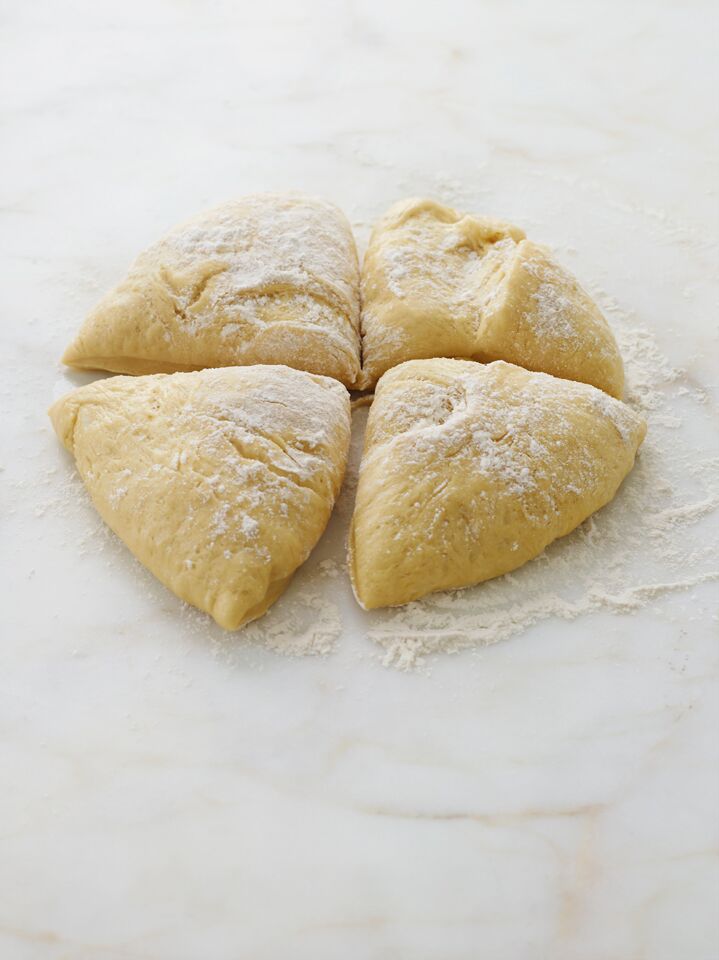
Stretch and roll each piece into a rope about 20-inches long. Lay the ropes parallel to one another (vertically). Pinch them tightly together at the top, and then fan them out. If the ropes shrink a bit, just work them back into their original length. Begin by taking the strand farthest to the right and weave it toward the left through the other strands using this pattern: over, under, over.
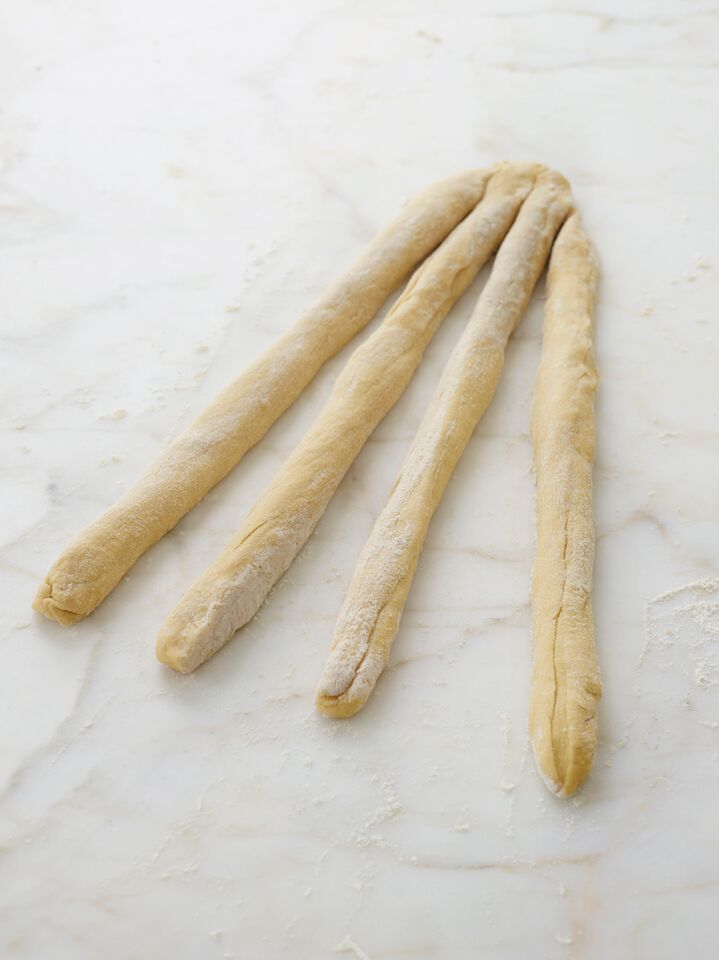
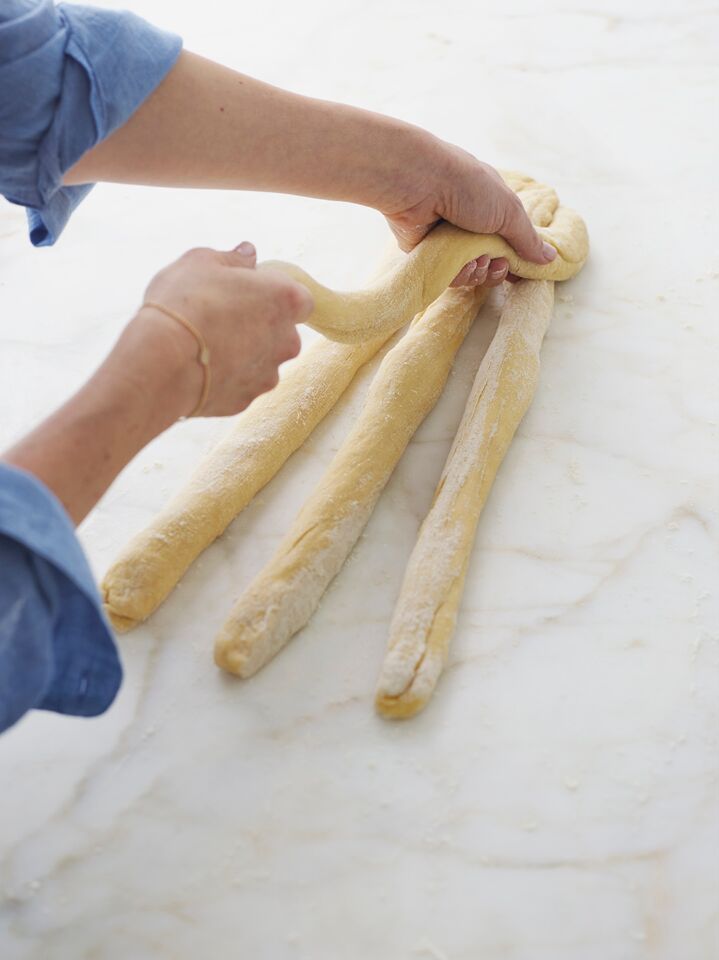
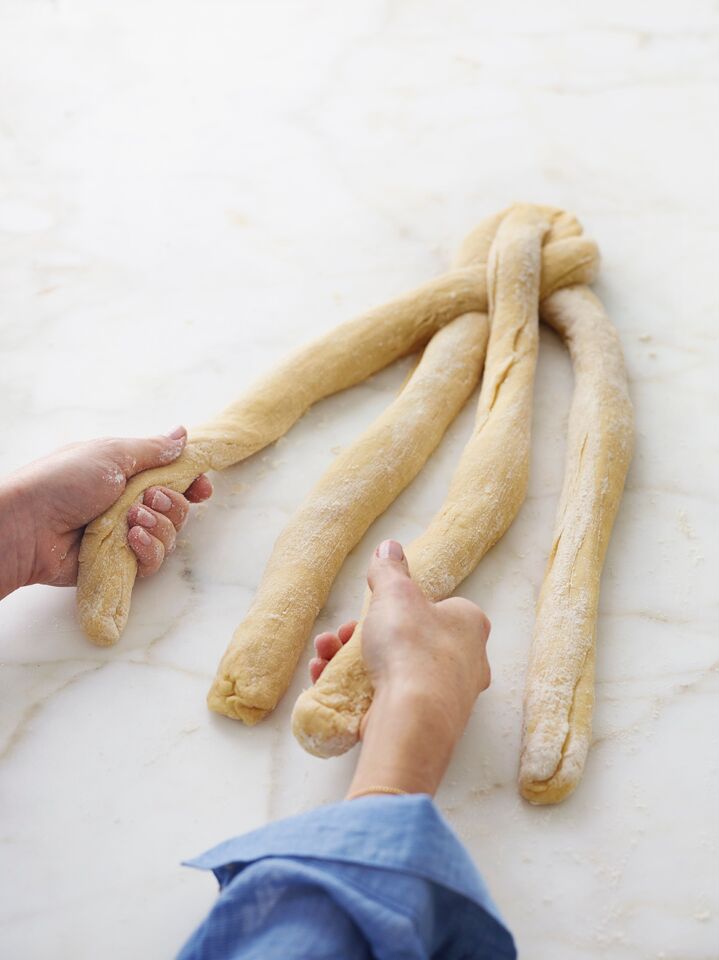
Take the strand furthest to the right and repeat the weaving pattern again: over, under, over.
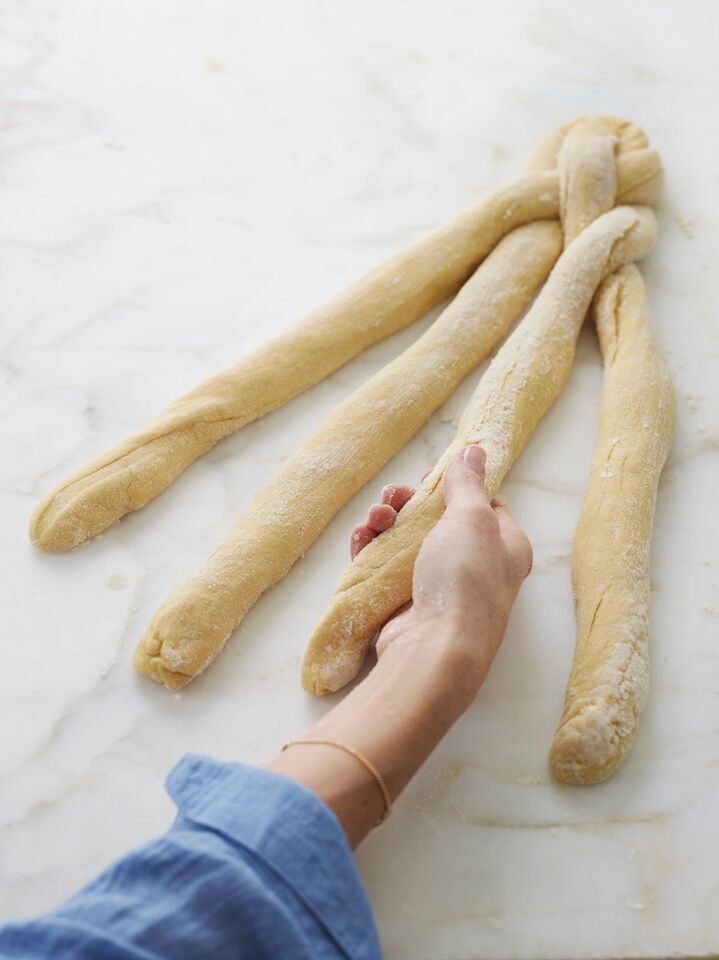
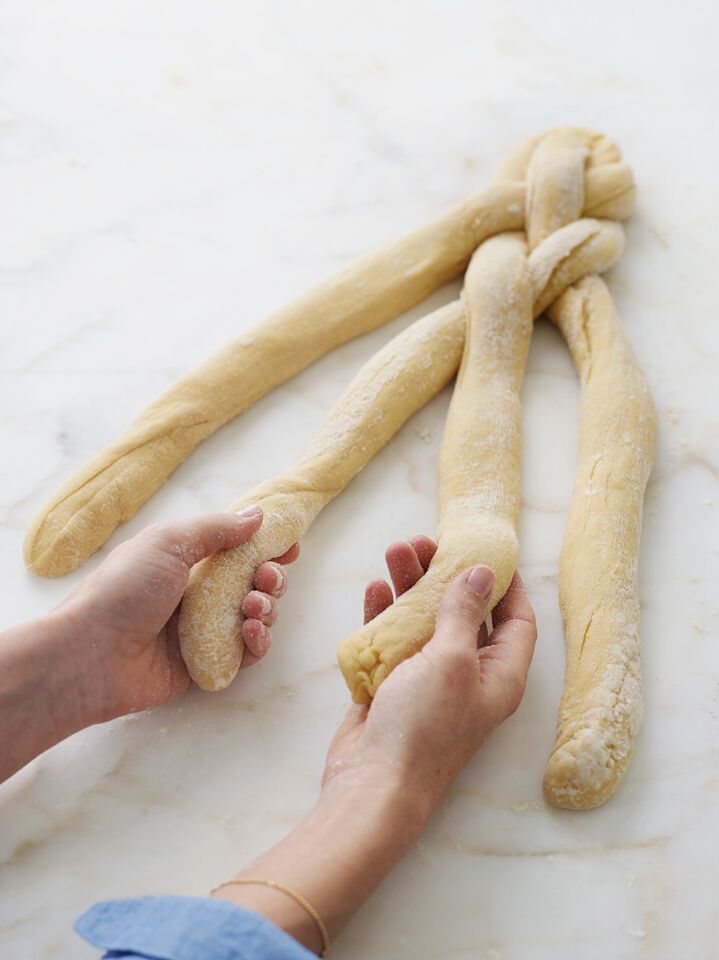
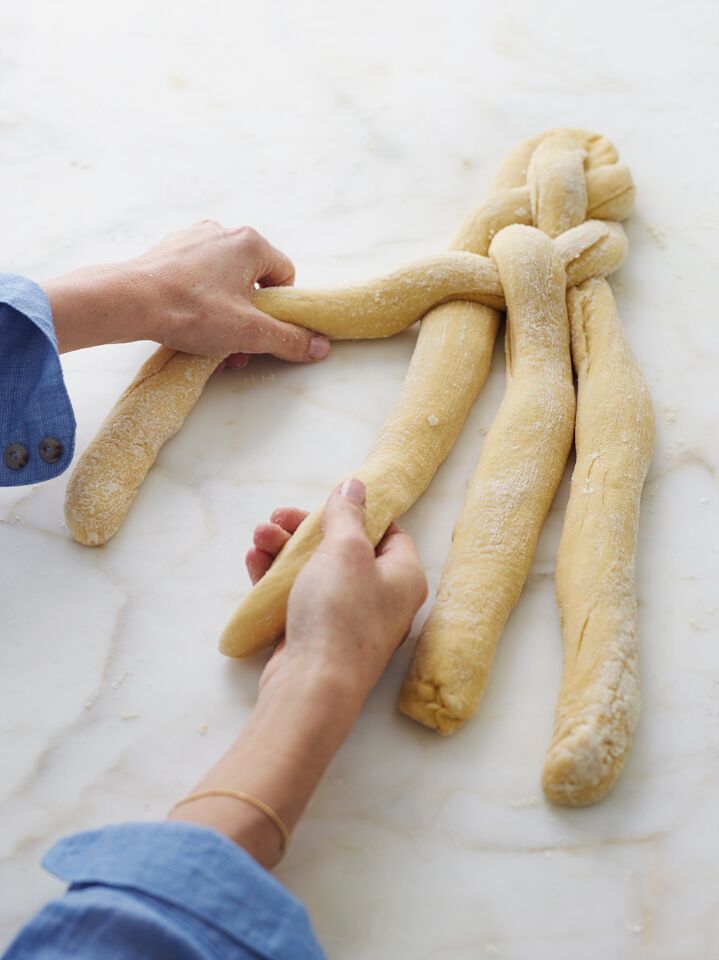
Repeat this pattern, always starting with the strand farthest to the right, until the whole loaf is braided.
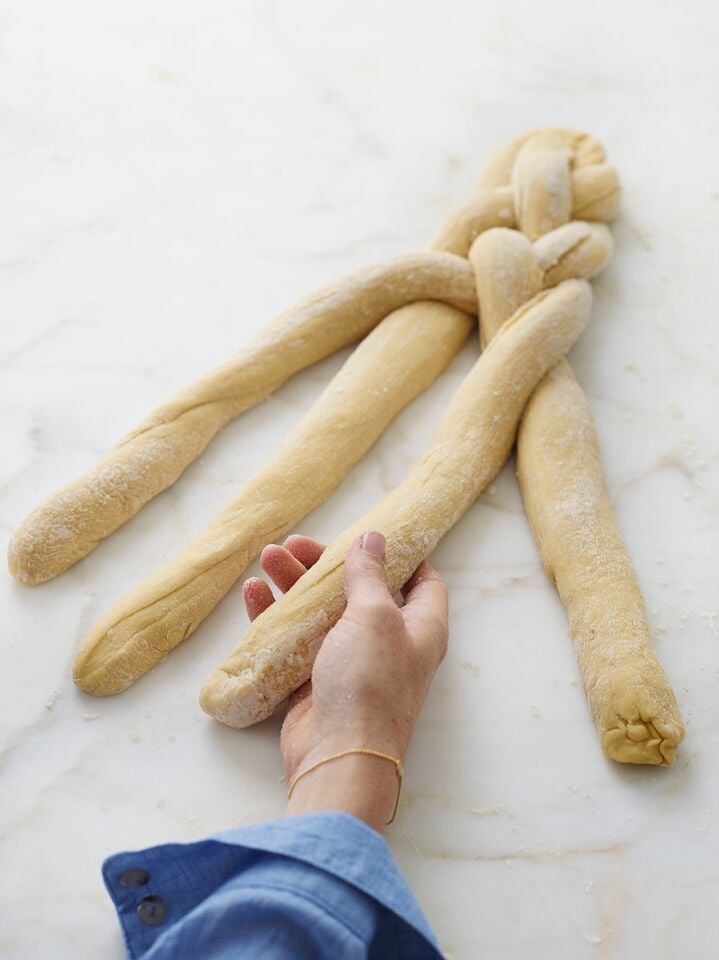
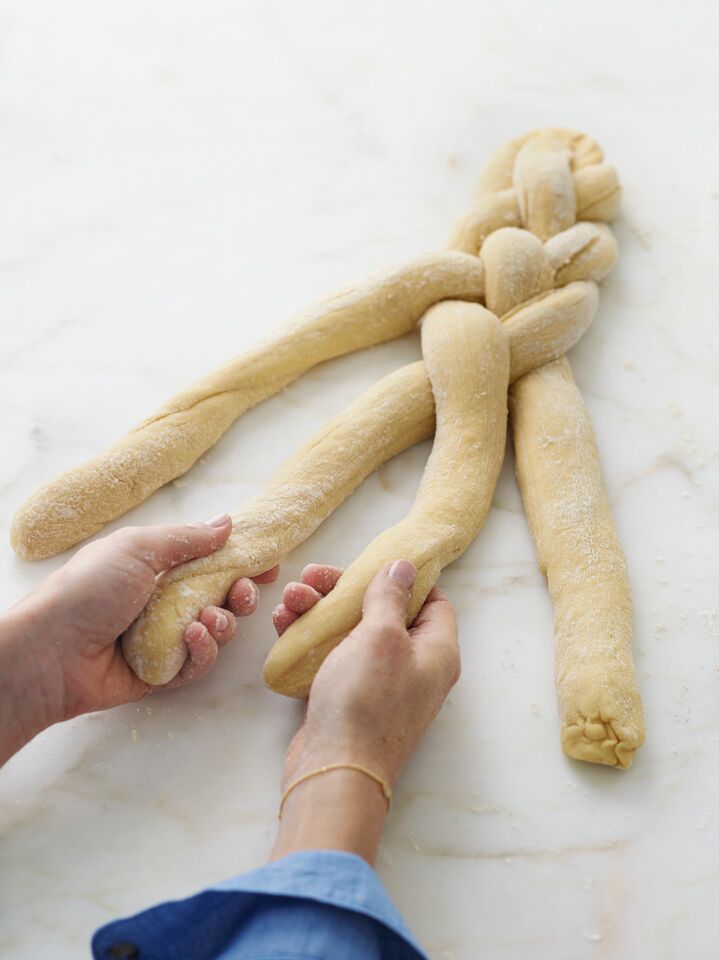
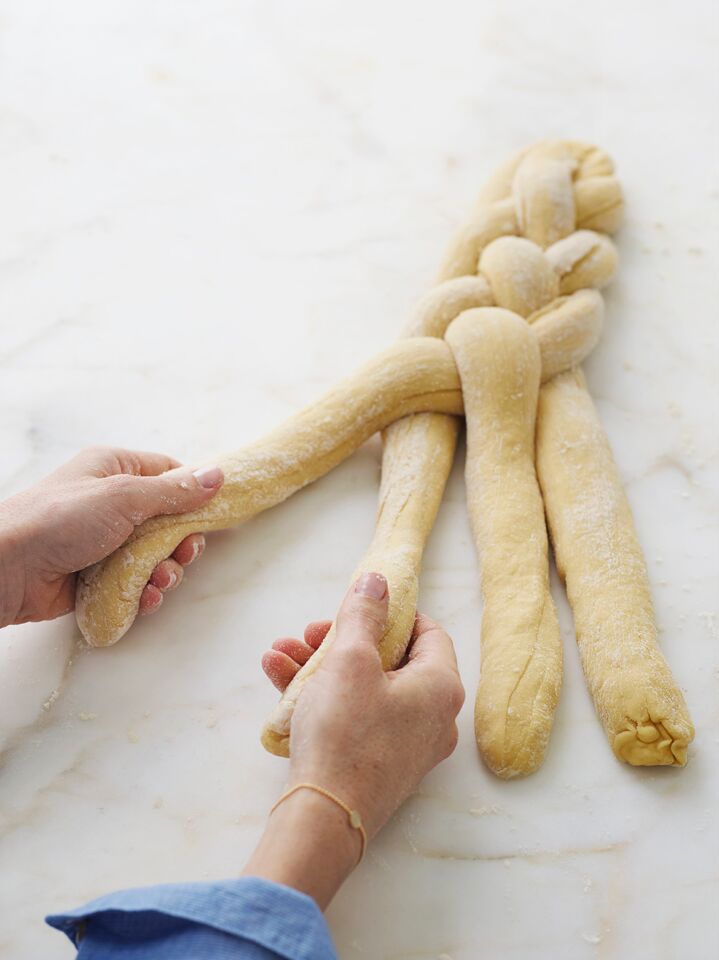
Tuck the ends under the loaf to give it a finished look.
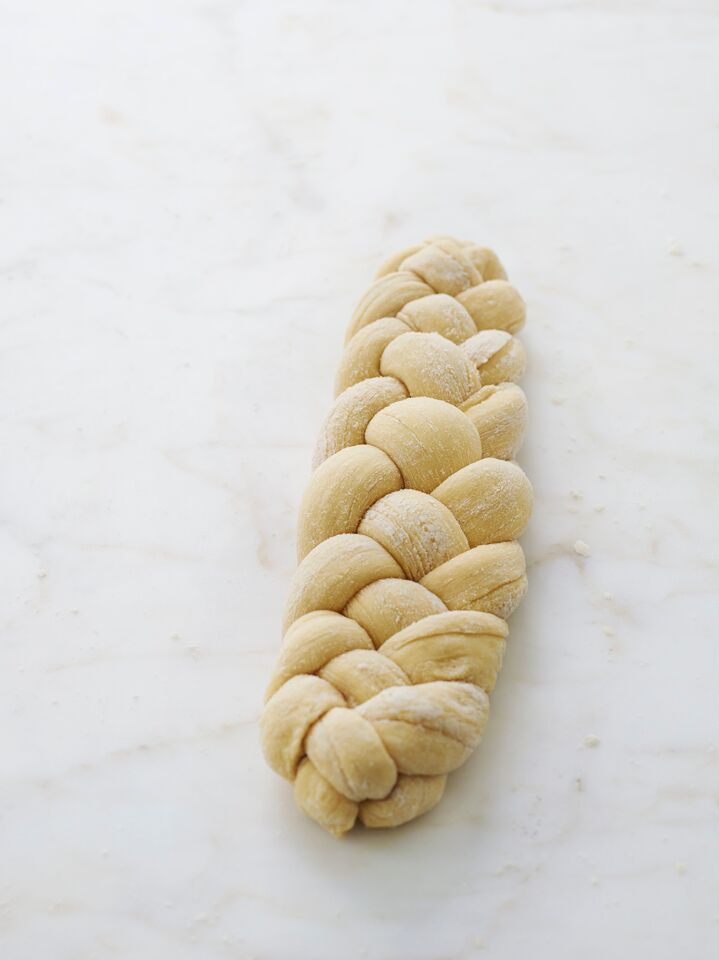
Step 4: Let the Braided Dough Rise
Carefully transfer the braided loaf to a parchment-lined 13 x 18-inch baking sheet. Cover the loaf loosely with plastic wrap and let it rise in a warm, draft-free spot until about 1.5 times the size, 1 to 2 hours. Toward the end of the rising time, preheat the oven to 350°F and set an oven rack in the middle position. (Note that the loaf will continue to rise a bit in the oven.) In a small bowl, beat the remaining egg and brush the beaten egg generously over the risen dough. (Note: If you like, sprinkle poppy or sesame seeds onto the challah before putting it in the oven.)
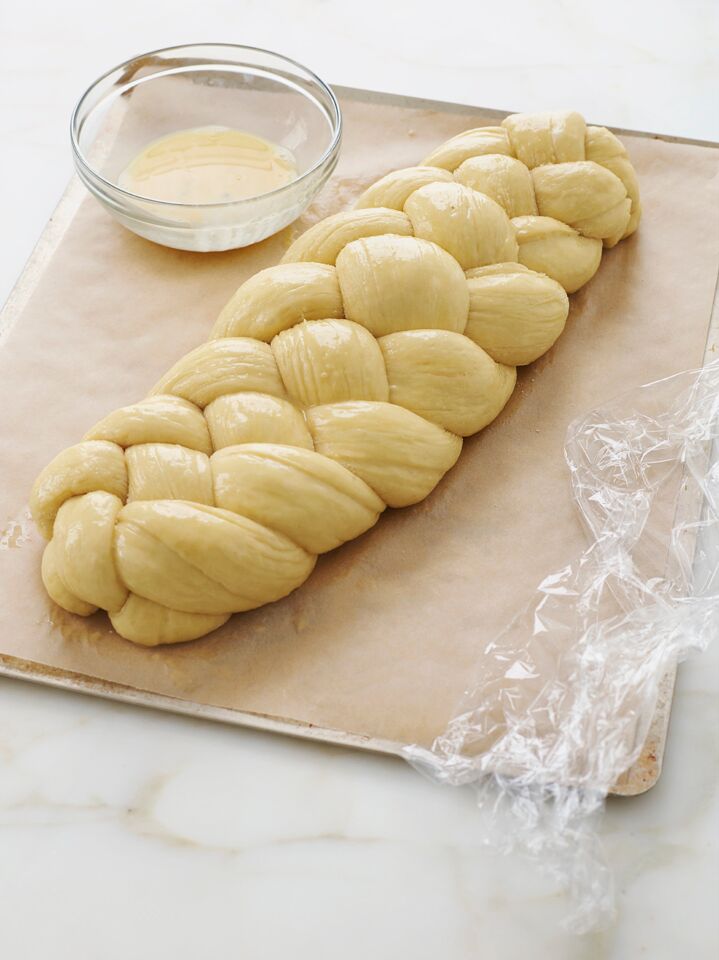
Step 5: Bake
Place the baking sheet atop another baking sheet; this will prevent the bottom crust from browning too much. Bake for 30 to 35 minutes, until the crust is a rich brown color and the internal temperature is between 190°F and 200°F on an instant-read thermometer. Remove the bread from the oven and place it on a rack to cool. Challah is best enjoyed fresh, but leftovers will keep for a few days in a sealed plastic bag.
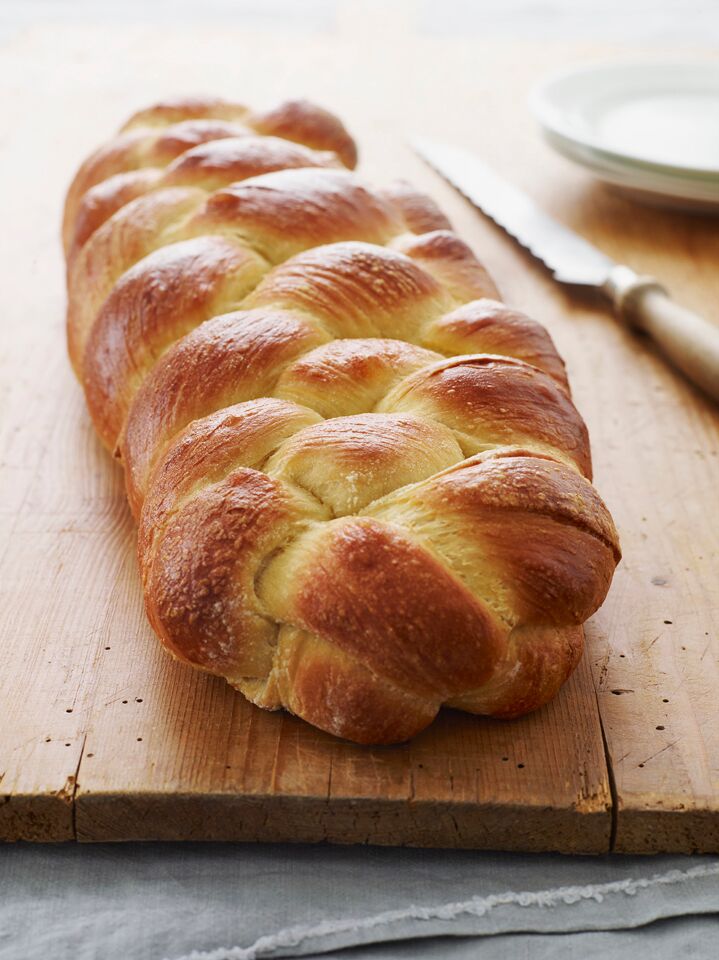
You May Also Like
Challah
With its rich, slightly sweet flavor, shiny golden crust, and pillowy interior, challah isn’t just for the Jewish holidays — it appeals to everyone, any time!
Ingredients
- 4¼ cups all-purpose flour, spooned into measuring cup and leveled-off, plus more for dusting
- 1 tablespoon instant/rapid-rise yeast (see note)
- 2 teaspoons salt
- ¾ cup lukewarm water
- ¼ cup + 2 tablespoons vegetable oil
- ¼ cup + 2 tablespoons honey
- 3 eggs, at room temperature
- 1 egg yolk, at room temperature
Instructions
- In a stand mixer fitted with the dough hook, combine the flour, yeast, and salt. Mix on low speed for 30 seconds to combine. In a separate bowl, combine the lukewarm water, oil, honey, 2 of the eggs, and the egg yolk. Add to the dry ingredients and knead on medium-low speed until you have a sticky dough that clings to the bottom of the bowl, 5 to 7 minutes. The dough may seem too wet but have faith—it’s supposed to be.
- Dust your hands generously with flour, then scrape the sticky, elastic dough out onto a lightly floured work surface. Dust the top of the dough lightly with flour and knead briefly into a soft, smooth ball. Lightly grease a large bowl with oil or nonstick cooking spray. Place the dough in the bowl, flip it over once so the top is lightly oiled, and then cover the bowl with plastic wrap. Allow the dough to rise in a warm, draft-free spot until it's puffy and doubled in size, 2 to 3 hours.
- Invert the dough onto a lightly floured work surface and dust with flour. It will deflate. Cut the dough into four even 9-oz pieces, and then stretch and roll each piece into a rope about 20-inches long. Lay the ropes parallel to one another (vertically). Pinch them tightly together at the top, and then fan them out. If the ropes shrink a bit, just work them back into their original length.
- Begin by taking the strand farthest to the right and weave it toward the left through the other strands using this pattern: over, under, over. Take the strand furthest to the right and repeat the weaving pattern again: over, under, over. Repeat this pattern, always starting with the strand farthest to the right, until the whole loaf is braided. Tuck the ends under to give the loaf a finished look.
- Carefully transfer the braided loaf to a parchment-lined 13 x 18-inch baking sheet. Cover the loaf loosely with plastic wrap and let it rise in a warm, draft-free spot until about 1.5 times the size, 1 to 2 hours. Toward the end of the rising time, preheat the oven to 350°F and set an oven rack in the middle position. (Note that the loaf will continue to rise significantly in the oven.)
- In a small bowl, beat the remaining egg and brush the beaten egg generously over the risen dough. (Note: If you like, sprinkle poppy or sesame seeds onto the challah before putting it in the oven.) Place the baking sheet atop another baking sheet; this will prevent the bottom crust from browning too much. Bake for 25 to 35 minutes, until the crust is a rich brown color and the internal temperature is between 190°F and 200°F on an instant-read thermometer. Remove the bread from the oven and place it on a rack to cool. Challah is best enjoyed fresh, but leftovers will keep for a few days in a sealed plastic bag.
- Note: If you're using yeast that comes in the packets, the quantity required for this recipe (1 tablespoon) is more than one packet.
- Note: Active dry yeast may be used instead of instant/rapid-rise yeast, however, the dough will take longer to rise.
- Note: When baking yeast breads, rising times are only a guide; the temperature in your kitchen, the humidity level outdoors, and how you knead the dough will all affect the rising time.
- Make-Ahead Instructions: Prepare the loaf up to the point where it's braided and on the pan. Cover it with greased plastic wrap, and place it in the refrigerator overnight. The next day, remove the braided dough from the refrigerator and set it on the countertop (keep it covered). Let it come to room temperature and rise for about 1 hour before baking as directed.
- Freezer-Friendly Instructions: Challah can be baked, cooled, tightly wrapped, and frozen for up to 3 months. Allow it to thaw at room temperature for at least 3 hours before serving.
Nutrition Information
Powered by ![]()
- Per serving (16 servings)
- Serving size: 1 slice
- Calories: 206
- Fat: 7 g
- Saturated fat: 1 g
- Carbohydrates: 32 g
- Sugar: 7 g
- Fiber: 1 g
- Protein: 5 g
- Sodium: 126 mg
- Cholesterol: 35 mg
This website is written and produced for informational purposes only. I am not a certified nutritionist and the nutritional data on this site has not been evaluated or approved by a nutritionist or the Food and Drug Administration. Nutritional information is offered as a courtesy and should not be construed as a guarantee. The data is calculated through an online nutritional calculator, Edamam.com. Although I do my best to provide accurate nutritional information, these figures should be considered estimates only. Varying factors such as product types or brands purchased, natural fluctuations in fresh produce, and the way ingredients are processed change the effective nutritional information in any given recipe. Furthermore, different online calculators provide different results depending on their own nutrition fact sources and algorithms. To obtain the most accurate nutritional information in a given recipe, you should calculate the nutritional information with the actual ingredients used in your recipe, using your preferred nutrition calculator.

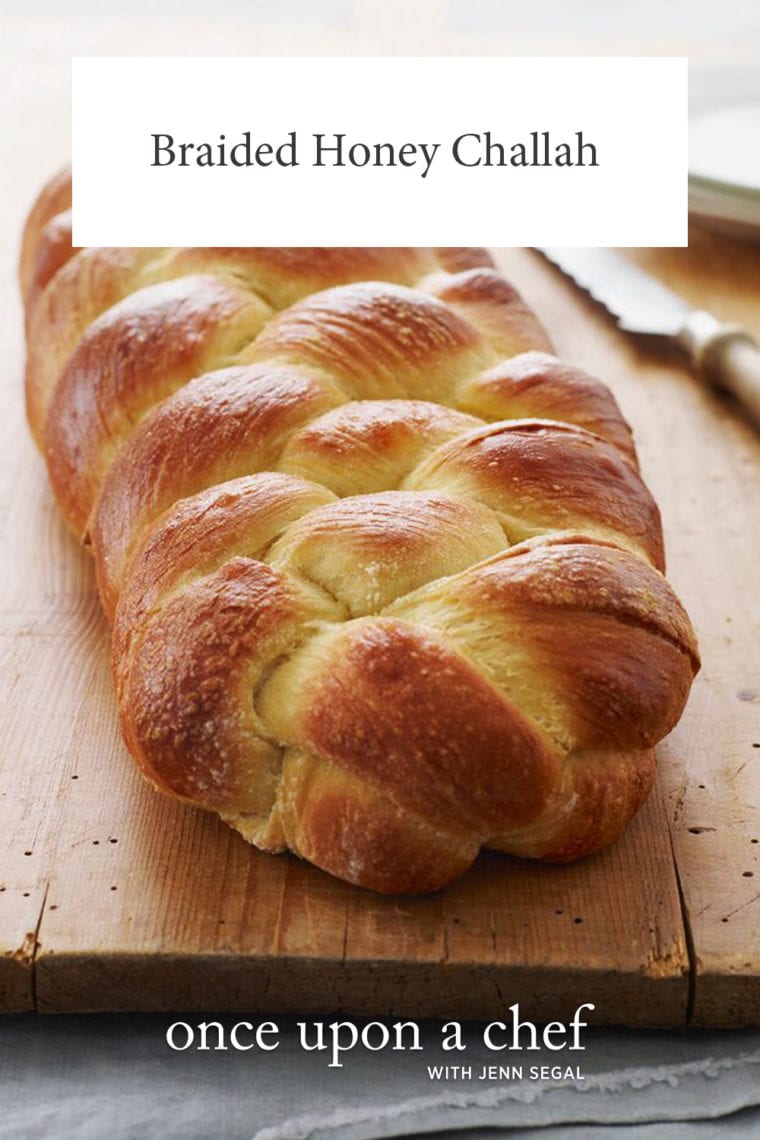
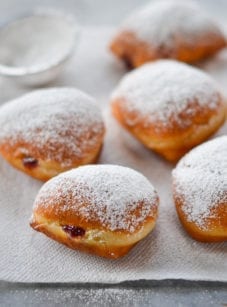
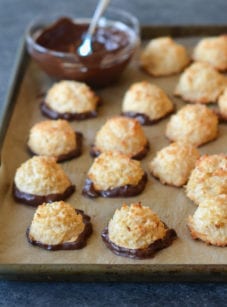
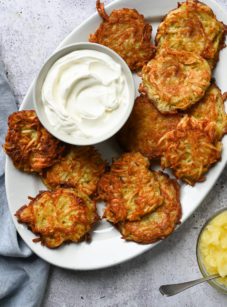
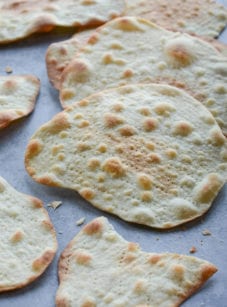
Hi Jenn! I’ve made this recipe a few times and the challah has always turned out great! But my dough is never wet and sticky enough to cling to the bowl. Do you know why that could be? Or why the challah still turns out so well? Thanks!
Hi Zoe, Perhaps you’re using slightly more flour than necessary and that’s why you’re finding the texture to be less sticky, but if it turns out well, I wouldn’t worry about it. 🙂
I have this challah in the oven right now, and it smells delicious! I made the recipe into two loaves of three strands instead of one larger loaf because I have a small family, and two loaves are essential for Shabbat, which is tonight.
I found the dough to be very dry, and I had to add water. Next time, if we like the flavor, I’ll just add another egg.
I always use the overnight rise in the fridge for the second rise, and it worked well. I used active dry yeast and did the first rise in my oven on “bread-proof” which sets the oven to 100 deg F, and it worked very quickly. The dough doubled and I left a dimple after only 2 hours. I don’t think instant yeast would have been any faster!
So if it’s as delicious as it smells right now (it’s out of the oven now), this will be my go-to challah recipe. Thank you!
Could we put raisins in this bread? How much would you recommend and at what step of the recipe? Thank you so much 🙂
Hi Alaina, Yes, you can add some raisins. I’d start with about 1/2 cup and if you like the results, you can increase the amount the next time you make it. I’d add them right at the end of when you’re kneading the dough in the mixer. Please LMK how it turns out!
I just made up this dough and I am wondering why all the warnings about stickyness? There was not enough liquid in the dough for 4.5 cups of flour to be sticky. I am wondering if I did it wrong and will my bread still be soft enough on the inside.
There is always some variation in bread baking, Jeanne. How did it turn out?
Mine was dry too! I added additional water and next time will use an egg.
Hi Jenn! I’d love to try this challah recipe but have a few questions. If I feel uncomfortable leaving the dough out for more than an hour or so because it has eggs in it can I do any of the rising in the refrigerator? I also don’t have a stand mixer but saw you said we can do it by hand though it might look a bit different than yours. Do you mean it might be flatter and if so is there anything we can do while mixing to try and avoid this? Lastly, I’m using Publix All Purpose Flour and live in Florida (I saw you said humidity can impact the rise) so I’m trying to decide what the best adjusted water and flour amounts may be. Publix All Purpose flour states it has 3g of protein on the ingredient label, I believe King Arthur which you recommend is 4g, but then I read something about differences between gluten-forming protein and nutritional protein so now I’m not sure how to compare them. Trying to put your suggestions into place, maybe I should reduce the flour by 1/2 cup as I’m mixing it by hand/it’s a different brand flour and reduce the water to 2/3 because of the humidity? Thank you for helping me troubleshoot in advance!
Hi Alyssa, if you knead the dough by hand, the dough may look a bit different but the finished challah should not. And regarding your questions about the type of flour and the level of humidity where you live, I wouldn’t make any changes to the amount of water or flour you’re using. If anything, because you’re kneading it by hand, you may need to add a bit more flour in order to be able to work with it. Please LMK how it turns out!
Thank you so much! I’ll leave the recipe as is and only use a little extra flour if the dough becomes hard to manage. If I’m uncomfortable with leaving the dough out for more than an hour or so because of the eggs could I do the first rise in the refrigerator?
I wouldn’t recommend doing the rise in the fridge. It will be too cold and inhibit rising.
I used this recipe for my first ever challah and it was incredible. My boyfriend must have eaten half of the loaf in one sitting. Thank you for the thorough and clear instructions. Making it again this week and hoping to master the braid! hehe.
Fantastic Challah Recipe. Super easy and yummy.
Hi there! Big fan 😊 I only have bread flour, what would be the measurements and directions please? Thank you!!
Hi Mumbles, I wouldn’t recommend bread flour here – I’m sorry!
What kind flour do you recommend? I’m new to baking.
Hi Jennifer, I’d go with the all-purpose flour that the recipe calls for. Hope you enjoy the challah!
This is the easiest bread recipe. I am not the best measurer and this bread always turns out. We live at over 5,000 feet, and it seems like things need a bit more flour than normal. I use the bread flour from King Arthur. When making this dough, let the dough tell you if you need a bit more flour. See how smooth it looks in the last picture (in the bowl), it will feel smooth and satiny. My braid has never been as pretty as hers, but it still tastes good.
And for adding a bit of flavor…
To ensure the flour did not dry out the dough, I greased the counter, hands, and rolling pin with a bit of butter.
Made the legs of the braid, rolled each flat (think long rectangles), sprinkled in some cinnamon sugar and craisins, rolled the legs back up, and braided as normal. After cooking, drizzle some frosting made from powdered sugar, orange zest, and orange juice.
Or for a savory loaf, use a bit of cheese. We used an Irish white cheddar. The boys thought it needed diced jalapenos.
The bread is fantastic as is and can be dressed sweet or savory.
Made this challah recipe for the first time. Recommend you follow the instructions for the flour measurement so you get it just perfect ! The 4 braid instructions were easy to follow too. Delicious challah – my new “go to” !